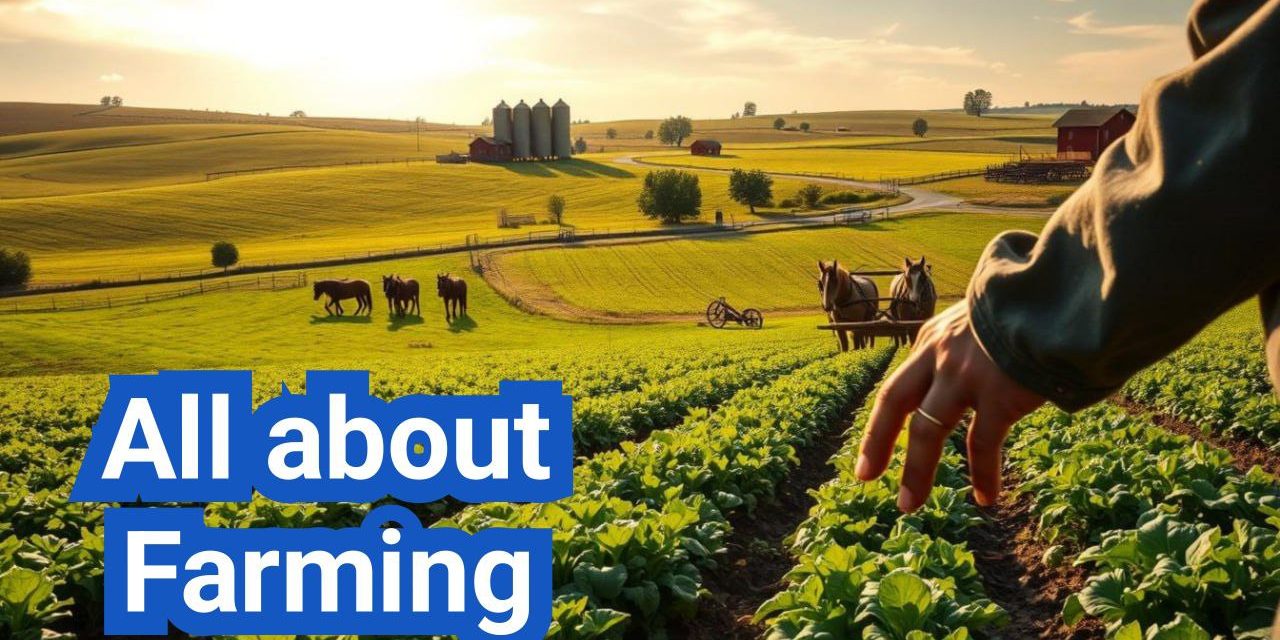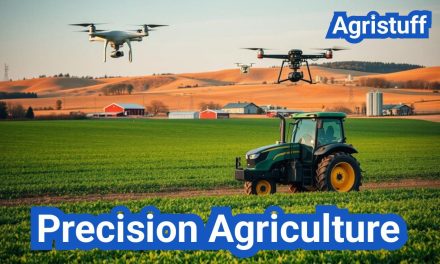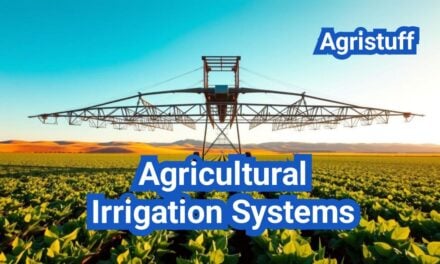Farming is the backbone of human civilization, providing sustenance and livelihoods for millions worldwide. As the global population grows, so does the demand for sustainable agricultural practices.
The challenges faced by farmers are multifaceted, from environmental concerns to market fluctuations. To address these issues, it’s essential to adopt innovative and sustainable methods that ensure the long-term viability of farming operations.
The Cultivating Success Program offers valuable resources for both new and experienced farmers, providing them with the tools necessary to develop a thriving small acreage farm. By focusing on planning and decision-making, farmers can navigate the complexities of modern agriculture.
Key Takeaways
- Understanding the importance of sustainable agricultural practices.
- Recognizing the challenges faced by modern farmers.
- Utilizing resources like the Cultivating Success Program for farming success.
- Adopting innovative methods to ensure long-term farming viability.
- Focusing on planning and decision-making for small acreage farms.
The Foundations of Modern Agriculture
The foundations of modern agriculture are rooted in a combination of historical knowledge and contemporary innovation. This blend of tradition and cutting-edge technology has transformed the agricultural landscape, making it more efficient and sustainable.
Defining Today’s Agricultural Landscape
Today’s agricultural landscape is characterized by the integration of agribusiness principles, sustainable agriculture practices, and agricultural technology. This modern approach to farming is not just about crop production; it’s about creating a viable business that contributes to the local and global economy while ensuring environmental stewardship.
The Cultivating Success Program exemplifies this modern approach by combining a weekly virtual classroom setting with an extensive collection of resources and experts. This comprehensive support system helps foster the success of new and existing farms and ranches, equipping them with the knowledge and tools needed to thrive in a competitive market.
The Evolution of Farming Practices
Farming practices have undergone significant evolution over the years, driven by advances in technology and changing environmental conditions. The adoption of precision farming techniques, for instance, has enabled farmers to optimize crop yields while minimizing environmental impact.
Sustainable agriculture practices, such as crop rotation and organic farming, have gained prominence as farmers seek to maintain soil health and reduce their reliance on chemical inputs. These practices not only contribute to environmental sustainability but also enhance the long-term viability of farming operations.
Key Components of Successful Farming Operations
Successful farming operations rely on several key components, including effective farm management, access to appropriate technology, and a well-planned business strategy. Farmers must be adept at managing resources, predicting and mitigating risks, and adapting to changing market conditions.
- Effective use of agricultural technology to enhance productivity and efficiency.
- Implementation of sustainable agriculture practices to ensure environmental sustainability.
- A robust business plan that takes into account market trends and consumer demands.
By focusing on these key components and staying abreast of the latest developments in agribusiness, farmers can build resilient and profitable farming operations that contribute to a sustainable food system.
Assessing Your Agricultural Potential

Assessing your agricultural potential involves a comprehensive evaluation of your land, climate, and market conditions. This foundational step is crucial for determining the viability of your farming operation and identifying areas for improvement.
Evaluating Land Suitability for Farming
Land suitability is a critical factor in agricultural success. It involves assessing the soil type, topography, and natural resources available on your land.
- Soil testing to determine nutrient levels and pH balance
- Topographical analysis to identify potential drainage issues or erosion risks
- Assessment of natural resources, such as water availability
Soil health is particularly important, as it directly impacts crop production and livestock management. Healthy soil can lead to more robust crops and healthier livestock, ultimately enhancing your farm’s productivity and sustainability.
Understanding Your Local Climate and Growing Seasons
Understanding your local climate and growing seasons is vital for planning your agricultural activities. This knowledge helps you make informed decisions about planting times, crop selection, and resource allocation.
| Climate Factor | Impact on Farming | Mitigation Strategies |
|---|---|---|
| Temperature Variations | Affects crop growth and livestock comfort | Use greenhouses or shading for temperature control |
| Rainfall Patterns | Influences water availability for crops and livestock | Implement irrigation systems or water conservation techniques |
“The way we farm, the way we manage our land, will determine the kind of world we leave behind for future generations.” – Unknown
Conducting Market Research for Agricultural Products
Conducting market research is essential for understanding the demand for your agricultural products and identifying potential market channels.
This involves analyzing consumer trends, competitor activity, and market prices to determine the most profitable products and sales strategies for your farm.
By carefully assessing your agricultural potential, you can make informed decisions that enhance your farm’s productivity, sustainability, and profitability.
Planning Your Agricultural Enterprise
To establish a thriving agricultural business, careful planning is essential. This involves several key components that work together to ensure the success and sustainability of the farming operation.
Creating a Comprehensive Farm Business Plan
A comprehensive farm business plan is the backbone of any successful agricultural enterprise. It outlines the farm’s goals, production strategies, marketing plans, and financial projections. The Agricultural Entrepreneurship course emphasizes the importance of business planning for new and current farmers, providing them with the skills needed to gain success in direct marketing and other areas.
When creating a farm business plan, it’s crucial to consider factors such as market demand, competition, and available resources. This plan should be regularly reviewed and updated to reflect changes in the market or the farm’s operations.
Budgeting for Agricultural Operations
Budgeting is a critical aspect of agricultural planning, as it helps farmers manage their finances effectively. A well-structured budget should account for all expenses, including equipment, labor, seeds, fertilizers, and other inputs.
| Expense Category | Estimated Cost | Actual Cost |
|---|---|---|
| Seeds and Fertilizers | $10,000 | $9,500 |
| Labor Costs | $20,000 | $21,000 |
| Equipment Maintenance | $5,000 | $4,800 |
Securing Financing and Agricultural Grants
Securing financing is often a challenge for agricultural enterprises. Farmers can explore various options, including loans, grants, and subsidies. Agricultural grants, in particular, can provide valuable support for new and existing farming operations.
To increase their chances of securing financing, farmers should prepare a solid business plan and financial projections. They should also be aware of the various government programs and initiatives that support agricultural development.
By carefully planning their agricultural enterprise, farmers can improve their chances of success and build a sustainable business. This involves creating a comprehensive farm business plan, budgeting effectively, and securing the necessary financing.
Essential Equipment and Infrastructure for Farming

Effective farming relies heavily on the right equipment and infrastructure to ensure productivity and sustainability. As farming operations become more complex, the need for appropriate tools, machinery, and facilities grows.
Basic Farming Tools and Machinery
The backbone of any farming operation is its tools and machinery. From tractors and plows to seed drills and harvesters, the right equipment can significantly enhance efficiency and yield. Modern farming has seen a shift towards mechanization, with precision agriculture technologies playing a crucial role in optimizing crop production and reducing waste.
Investing in quality equipment that suits the specific needs of the farm is crucial. This includes considering factors such as the size of the farm, the type of crops being grown, and the local terrain.
Farm Buildings and Storage Facilities
Adequate storage facilities are essential for protecting crops and equipment from the elements. Farm buildings such as barns, silos, and storage sheds are vital for maintaining the quality of produce and ensuring that equipment is kept in good condition.
The design and construction of these buildings should take into account the specific requirements of the farm, including the need for climate control, security, and accessibility.
Irrigation Systems and Water Management Infrastructure
Effective water management is critical for successful farming. Irrigation systems allow farmers to control water distribution, ensuring that crops receive the right amount of moisture at the right time. This not only improves crop yields but also helps in conserving water.
Modern irrigation technologies, including drip irrigation and sprinkler systems, offer efficient ways to manage water resources. Additionally, investing in water storage facilities such as ponds or reservoirs can help mitigate the risks associated with droughts.
By focusing on these essential elements, farmers can build a solid foundation for their operations, leveraging agricultural technology to enhance productivity and sustainability.
Soil Health Management: The Foundation of Success
Soil health is the backbone of sustainable agriculture, influencing crop production and overall farm viability. Effective soil health management is crucial for maintaining the productivity and environmental sustainability of farming practices.
Understanding Soil Types and Testing
Soil types vary significantly across different regions, each with its unique characteristics and requirements. Understanding your soil type is essential for determining its potential and limitations. Soil testing is a critical step in assessing soil health, providing valuable information on nutrient levels, pH, and contaminant presence.
By conducting regular soil tests, farmers can make informed decisions about fertilizer application, soil amendments, and other management practices that impact soil health.
Improving Soil Fertility Naturally
Improving soil fertility naturally is vital for sustainable agriculture. This can be achieved through the use of organic amendments, such as compost and manure, which enhance soil structure and nutrient content. Cover cropping and incorporating crop residues into the soil also contribute to improved soil fertility.
These practices not only boost soil health but also reduce the reliance on synthetic fertilizers, promoting a more environmentally friendly farming system.
Implementing Effective Crop Rotation Strategies
Crop rotation is a powerful tool for maintaining soil health. By rotating crops, farmers can break disease and pest cycles, improve soil nutrient profiles, and increase biodiversity. Effective crop rotation strategies involve planning and understanding the specific needs and benefits of different crops.
For example, rotating legumes with cereals can enhance soil nitrogen levels, reducing the need for synthetic fertilizers. By adopting crop rotation, farmers can improve soil health, increase crop yields, and contribute to sustainable agriculture.
Crop Production Fundamentals

Understanding the basics of crop production is vital for farmers aiming to optimize their yields and minimize losses due to pests, diseases, and environmental factors. Effective crop production involves a combination of traditional knowledge, modern technology, and sustainable practices.
Selecting the Right Crops for Your Environment
Choosing the appropriate crops for your farm is crucial for successful crop production. Factors such as soil type, climate, and market demand should be considered when making this decision.
- Soil type and fertility
- Climate and weather patterns
- Market demand and price trends
For instance, crops like soybeans and corn are commonly grown in regions with fertile soils and adequate moisture. In contrast, drought-resistant crops like sorghum may be more suitable for areas with limited water resources.
Planting Techniques and Timing
The technique and timing of planting are critical for maximizing crop yields. Proper spacing, depth, and timing can significantly impact crop performance.
| Crop | Optimal Planting Depth (inches) | Recommended Spacing (inches) |
|---|---|---|
| Corn | 1.5 – 2.5 | 6 – 8 |
| Soybeans | 1 – 1.5 | 3 – 6 |
| Wheat | 1 – 2 | 6 – 12 |
Pest and Disease Management in Crops
Effective management of pests and diseases is essential for maintaining healthy crops and achieving high yields. This involves a combination of preventive measures, monitoring, and control strategies.
Integrated Pest Management (IPM) strategies include:
- Crop rotation and sanitation
- Use of resistant varieties
- Biological control methods
- Chemical control as a last resort
By adopting a holistic approach to crop production, farmers can improve their yields, reduce environmental impact, and contribute to a more sustainable agricultural system.
Livestock Management Essentials
The backbone of a thriving agricultural enterprise lies in its livestock management practices. Effective livestock management is crucial for maximizing productivity, ensuring animal welfare, and maintaining a profitable farming operation.
Choosing Appropriate Livestock for Your Farm
Selecting the right livestock is a critical decision that depends on several factors, including climate, available land, market demand, and the farmer’s expertise. Diversity in livestock can help spread risk and create multiple revenue streams.
For instance, cattle are often raised for meat, milk, or breeding purposes, while poultry are commonly raised for eggs or meat. The choice between these options should be guided by market demand and the suitability of the local environment.
Animal Housing and Welfare Considerations
Providing appropriate housing for livestock is essential for their health and productivity. Housing should protect animals from extreme weather conditions, predators, and disease. Proper ventilation, sanitation, and space are critical components of animal housing.
Animal welfare considerations also play a significant role in livestock management. Ensuring that animals are treated humanely and with respect is not only ethical but can also improve productivity and reduce the risk of disease.
Feeding, Health, and Breeding Programs
Nutritional feeding programs are vital for maintaining the health and productivity of livestock. The quality and quantity of feed can significantly impact growth rates, milk production, and overall animal health.
Regular health checks and preventative measures, such as vaccinations, are crucial for preventing disease outbreaks. Breeding programs should be carefully planned to improve the genetic quality of the livestock, enhancing desirable traits such as fertility, growth rate, and disease resistance.
“The way we treat our animals reflects our values as a society. By prioritizing animal welfare, we not only improve the lives of these animals but also contribute to a more sustainable and ethical food system.” – Temple Grandin
By focusing on these key areas, farmers can develop a comprehensive livestock management strategy that enhances productivity, ensures animal welfare, and contributes to the overall success of the farm.
Sustainable Agriculture Practices for Long-Term Viability

Sustainable agriculture practices offer a pathway to environmentally conscious farming that ensures long-term productivity. As the agricultural sector continues to evolve, adopting methods that reduce environmental impact while maintaining economic viability is crucial.
Implementing Organic Farming Methods
Organic farming is a cornerstone of sustainable agriculture, focusing on natural processes and avoiding synthetic inputs. This approach not only improves soil health but also reduces the environmental footprint of farming operations. Key strategies include using organic amendments, crop rotation, and integrated pest management.
Organic amendments, such as compost and manure, enhance soil fertility and structure, promoting healthy plant growth. Crop rotation plays a critical role in maintaining soil health, breaking pest cycles, and improving biodiversity.
Conservation Techniques for Environmental Protection
Conservation techniques are vital for protecting natural resources and maintaining ecosystem services. Practices such as cover cropping, reduced tillage, and habitat restoration contribute to soil conservation, water quality improvement, and biodiversity enhancement.
- Cover cropping helps reduce soil erosion and improves soil health.
- Reduced tillage minimizes soil disturbance, preserving organic matter and reducing erosion.
- Habitat restoration supports biodiversity by providing habitats for beneficial organisms.
Reducing the Carbon Footprint of Farming Operations
Reducing the carbon footprint of farming is essential for mitigating climate change. Strategies include optimizing energy use, adopting renewable energy sources, and implementing practices that enhance carbon sequestration. Precision agriculture and regenerative agriculture are emerging as effective approaches to reduce greenhouse gas emissions.
By integrating these sustainable agriculture practices, farmers can not only reduce their environmental impact but also improve the resilience and productivity of their operations. As the global population continues to grow, the importance of sustainable agriculture in ensuring food security and environmental stewardship cannot be overstated.
Agricultural Technology and Innovation

Innovation in agricultural technology is paving the way for a more sustainable and profitable farming industry. The use of technology in farming has become increasingly prevalent, transforming the way crops are grown, harvested, and managed.
Precision Farming Technologies
Precision farming involves the use of advanced technology and data analysis to optimize crop yields and reduce waste. Techniques include GPS-guided equipment, drones, and satellite imaging, which enable farmers to monitor and manage their fields more effectively.
Farm Management Software and Applications
Farm management software and mobile applications are becoming essential tools for farmers, helping them to streamline operations, track inventory, and analyze data. These digital solutions enable farmers to make informed decisions, improving efficiency and productivity.
Emerging Technologies Transforming Agriculture
The agricultural sector is on the cusp of a technological revolution, with emerging technologies such as artificial intelligence, blockchain, and the Internet of Things (IoT) set to transform farming practices. These innovations promise to enhance sustainability, improve crop resilience, and increase profitability.
As the agricultural industry continues to evolve, embracing agricultural technology and innovation will be crucial for farmers to remain competitive and achieve long-term success.
Water Management Strategies for Farms

Water management strategies are essential for farmers to ensure sustainable agricultural practices. Effective water management not only helps in conserving this precious resource but also plays a critical role in improving crop yields and reducing the environmental impact of farming operations.
Efficient Irrigation Techniques
Efficient irrigation is at the heart of water management in agriculture. Techniques such as drip irrigation and sprinkler irrigation have proven to be highly effective in delivering water directly to the roots of plants, thus minimizing evaporation and runoff. Precision irrigation, which involves the use of technology to optimize irrigation schedules based on soil moisture levels and weather forecasts, is becoming increasingly popular among farmers.
Another approach is the use of mulching and cover cropping, which help retain soil moisture and reduce the need for frequent irrigation. These practices not only conserve water but also contribute to soil health by adding organic matter and reducing erosion.
Water Conservation Practices
Water conservation is an integral part of water management on farms. Practices such as rainwater harvesting allow farmers to collect and store rainwater for use during dry periods, reducing reliance on groundwater and surface water sources. Implementing water-saving technologies and practices, such as lining irrigation canals and using water-efficient appliances, can also significantly reduce water waste.
Moreover, adopting conservation tillage and reduced tillage practices can help in preserving soil moisture, reducing soil erosion, and promoting water infiltration. These practices contribute to a more sustainable use of water resources in agriculture.
Dealing with Drought and Excess Water Challenges
Farmers often face challenges related to both drought and excess water. During droughts, implementing drought-tolerant crops and using mulches can help mitigate the impact on crop yields. For excess water, having proper drainage systems in place is crucial to prevent waterlogging, which can be detrimental to plant health.
Additionally, using flood-resistant crops and implementing waterlogging tolerance practices can help manage excess water conditions. Farmers can also benefit from developing a water management plan that includes strategies for both drought and flood conditions, ensuring the resilience of their farming operations.
Marketing Your Agricultural Products

In the competitive world of agribusiness, marketing your products effectively is key to standing out.
Successful marketing in agriculture involves understanding your target audience and developing strategies to reach them. This can include direct-to-consumer sales, partnerships with distributors and retailers, and building a strong brand identity.
Direct-to-Consumer Sales Strategies
Direct-to-consumer sales allow farmers to connect directly with customers, potentially increasing profit margins and building brand loyalty. Strategies include:
- Farmers’ markets
- Community Supported Agriculture (CSA) programs
- Online sales platforms
These methods enable farmers to gather feedback from consumers and tailor their products to meet demand.
Working with Distributors and Retailers
Partnering with distributors and retailers can expand a farm’s reach beyond local markets. To succeed, farmers should:
- Develop strong relationships with partners
- Ensure consistent product quality
- Negotiate fair prices
Understanding the supply chain and logistics is crucial for maintaining product freshness and meeting retailer demands.
Building Your Farm Brand and Online Presence
A strong brand identity helps differentiate a farm’s products in a crowded market. Key elements include:
- A compelling brand story
- Consistent visual branding
- Engaging online content
An effective online presence, including social media and a dedicated website, can enhance a farm’s visibility and attract new customers.
To illustrate the effectiveness of different marketing strategies, consider the following comparison:
| Marketing Strategy | Target Audience | Potential Reach |
|---|---|---|
| Direct-to-Consumer | Local Customers | High Engagement |
| Distributors/Retailers | Broader Market | Wide Reach |
| Online Presence | Global Audience | Variable, depends on marketing |
By combining these strategies, agricultural businesses can develop a comprehensive marketing approach that meets their unique needs and goals.
Navigating Regulations in Agriculture

Farmers must adeptly navigate the complex landscape of agricultural regulations to achieve long-term success. These regulations are multifaceted, covering various aspects of farming operations.
Understanding Agricultural Zoning and Land Use Laws
Agricultural zoning and land use laws dictate how land can be utilized for farming purposes. These laws vary by jurisdiction and are crucial for determining the suitability of land for specific agricultural activities. Compliance with these regulations helps prevent legal issues and ensures that farming operations are conducted in harmony with local land use plans.
Food Safety Regulations and Compliance
Food safety regulations are critical in ensuring that agricultural products are safe for consumption. Farmers must adhere to guidelines that govern the handling, storage, and processing of produce. This includes implementing good agricultural practices (GAPs) and maintaining detailed records of farming activities. Compliance with food safety regulations not only protects consumers but also enhances the marketability of farm products.
Environmental Regulations for Farming Operations
Environmental regulations play a vital role in protecting natural resources and minimizing the environmental impact of farming operations. These regulations cover aspects such as water usage, soil conservation, and the management of chemical inputs. By complying with environmental regulations, farmers can contribute to the sustainability of their operations and reduce their ecological footprint.
The Cultivating Success Program provides valuable information on navigating these agricultural regulations, emphasizing the importance of compliance in ensuring sustainable agricultural practices. By understanding and adhering to these regulations, farmers can avoid legal pitfalls, improve their operational efficiency, and contribute to a more sustainable agricultural sector.
Overcoming Common Challenges in Farming

Farming is a complex endeavor that involves managing a multitude of risks, including weather-related events, labor shortages, and market volatility. As farmers navigate these challenges, they must also adapt to changing environmental conditions, regulatory requirements, and market demands.
Managing Weather-Related Risks
Weather-related risks are a significant challenge for farmers, with events such as droughts, floods, and storms potentially devastating crops and livestock. To mitigate these risks, farmers can employ various strategies, including:
- Implementing irrigation systems to manage water supply during droughts
- Using crop insurance to protect against crop failure
- Employing conservation tillage to reduce soil erosion
Addressing Labor Shortages and Management
Labor shortages and management are another significant challenge facing farmers. To address these issues, farmers can:
- Invest in mechanization and automation to reduce labor requirements
- Implement effective labor management practices to optimize workforce productivity
- Explore alternative labor sources, such as migrant workers or local community programs
Dealing with Market Volatility and Price Fluctuations
Market volatility and price fluctuations can also have a significant impact on farming operations. To manage these risks, farmers can:
- Diversify their product offerings to reduce dependence on a single crop or market
- Develop direct-to-consumer sales channels to increase profit margins
- Use price hedging strategies to mitigate the impact of price fluctuations
By understanding and addressing these common challenges, farmers can develop effective strategies to mitigate risks and ensure the long-term success of their operations.
Resources and Support for Agricultural Success
To cultivate success, farmers must have access to comprehensive resources and support. The agricultural sector is complex, and having the right backing can make a significant difference in productivity and sustainability.
Government Programs and Agricultural Extensions
Government programs play a crucial role in supporting farmers through various initiatives, including financial assistance, technical guidance, and research funding. For instance, the Cultivating Success Program, a collaboration between Rural Roots, University of Idaho, and Washington State University, offers educational resources and support for farmers. These programs help farmers adopt best practices, improve crop yields, and navigate regulatory requirements.
Key government resources include:
- Farm Service Agency (FSA) programs for financial assistance
- Natural Resources Conservation Service (NRCS) for conservation practices
- Agricultural Research Service (ARS) for innovative farming techniques
Farming Associations and Cooperatives
Farming associations and cooperatives provide valuable support to farmers by offering networking opportunities, market access, and collective bargaining power. These organizations help farmers stay updated on industry trends, best practices, and new technologies. They also advocate for farmers’ interests at local, state, and national levels.
Benefits of farming associations include:
- Access to training and workshops
- Market information and analysis
- Advocacy and policy influence
Educational Resources and Continuing Education
Continuing education is vital for farmers to stay abreast of the latest agricultural practices, technologies, and sustainability methods. Educational resources range from online courses and workshops to degree programs and certification courses. These resources help farmers improve their skills, adapt to changing conditions, and make informed decisions.
Examples of educational resources include:
- University extension programs
- Online platforms like Coursera and edX
- Industry-specific training programs
By leveraging these resources and support systems, farmers can enhance their agricultural practices, improve productivity, and contribute to a sustainable food system.
Finally: Cultivating Your Path to Agricultural Success
Achieving agricultural success requires a combination of knowledge, resources, and sustainable practices. The Cultivating Success Program is designed to support new and existing farms and ranches in their journey to success.
By applying the principles outlined in this guide, farmers can improve their operations, increase productivity, and contribute to a more sustainable agricultural industry. Sustainable agriculture practices, such as organic farming methods and conservation techniques, play a crucial role in ensuring the long-term viability of farming operations.
As the agricultural landscape continues to evolve, it’s essential for farmers to stay informed about the latest technologies, regulations, and market trends. By leveraging resources, such as government programs, farming associations, and educational resources, farmers can overcome common challenges and achieve their goals.
Ultimately, cultivating success in agriculture requires a commitment to continuous learning, innovation, and sustainability. By working together, farmers, policymakers, and industry stakeholders can create a thriving agricultural sector that benefits both the environment and the economy.
FAQ
What are the key components of successful farming operations?
Successful farming operations involve a combination of factors, including adapting to new technologies, implementing sustainable agricultural practices, and maintaining soil health. Effective crop production and livestock management are also crucial.
How can I assess my agricultural potential?
To assess your agricultural potential, evaluate your land suitability, understand your local climate conditions, and conduct market research for your agricultural products. Soil health is also a critical factor to consider.
What is the importance of soil health in agriculture?
Soil health is essential for agricultural success, as it directly impacts crop production and livestock management. Understanding soil types, testing, and implementing natural methods to improve fertility are vital for maintaining soil health.
What are some effective strategies for managing water in agriculture?
Effective water management strategies include efficient irrigation techniques, water conservation practices, and dealing with drought and excess water challenges. Implementing sustainable agriculture practices is also crucial for water management.
How can I market my agricultural products effectively?
To market your agricultural products effectively, consider direct-to-consumer sales strategies, working with distributors and retailers, and building your farm brand and online presence. Agribusiness plays a significant role in promoting farming products.
What are some common challenges faced by farmers, and how can they be overcome?
Common challenges faced by farmers include managing weather-related risks, addressing labor shortages, and dealing with market volatility and price fluctuations. Strategies for mitigating these risks include diversifying crops, implementing agricultural technology, and accessing resources and support.
What resources are available to support agricultural success?
Resources available to support agricultural success include government programs, farming associations, and educational resources. Continuing education is essential for staying up-to-date with the latest agricultural practices and technologies.
How can agricultural technology improve farming efficiency?
Agricultural technology, such as precision farming, farm management software, and emerging technologies, can significantly improve farming efficiency by optimizing crop production, livestock management, and resource allocation.
What are some sustainable agriculture practices that can be implemented?
Sustainable agriculture practices include implementing organic farming methods, conservation techniques, and reducing the carbon footprint of farming operations. These practices promote long-term viability and environmental protection.
How can I create a comprehensive farm business plan?
To create a comprehensive farm business plan, consider factors such as budgeting, securing financing, and implementing effective agricultural practices. A well-planned business strategy is essential for agricultural success.










